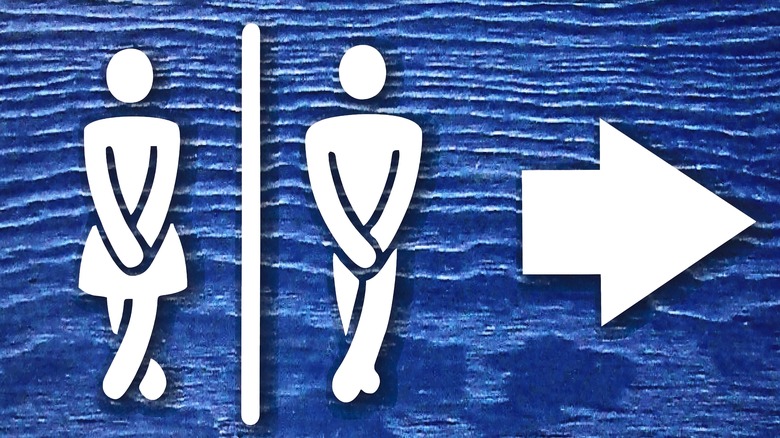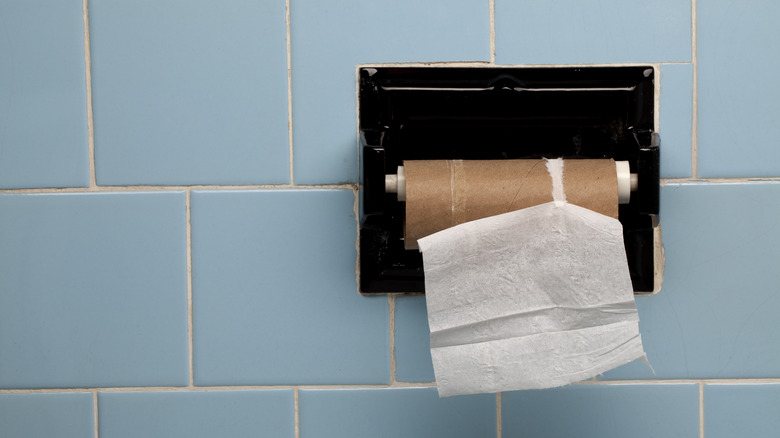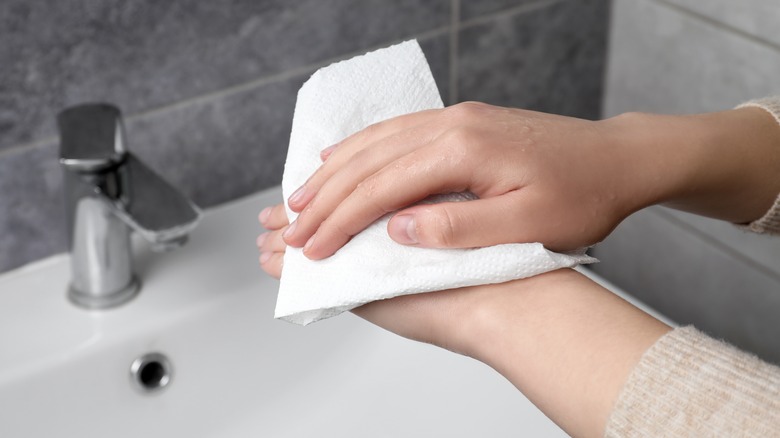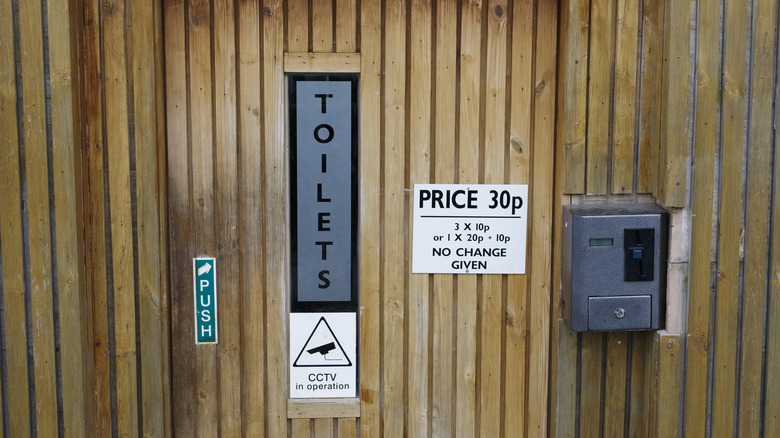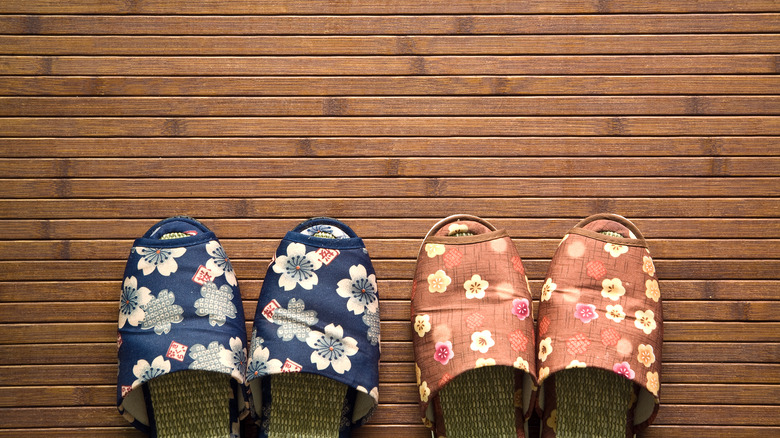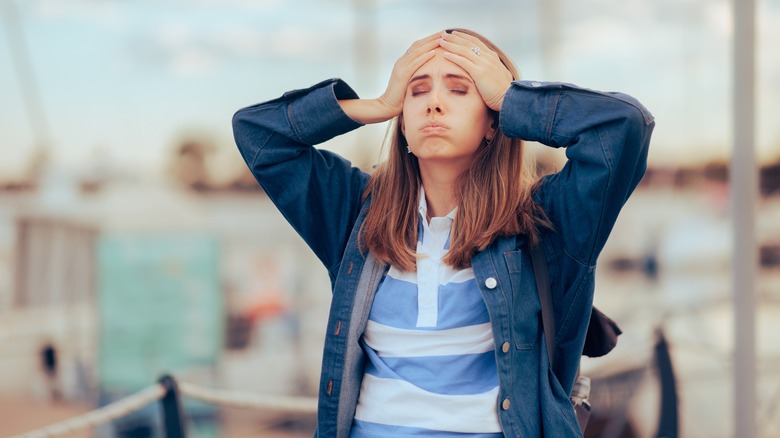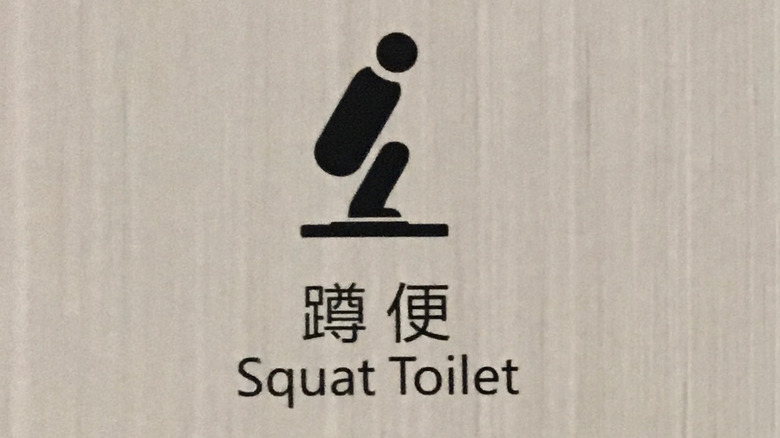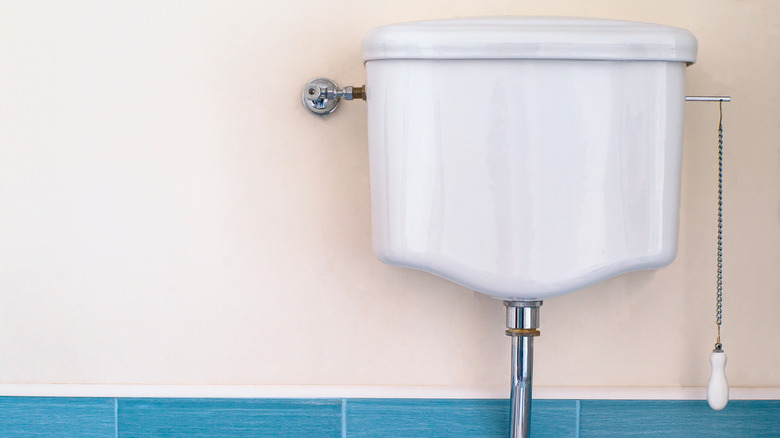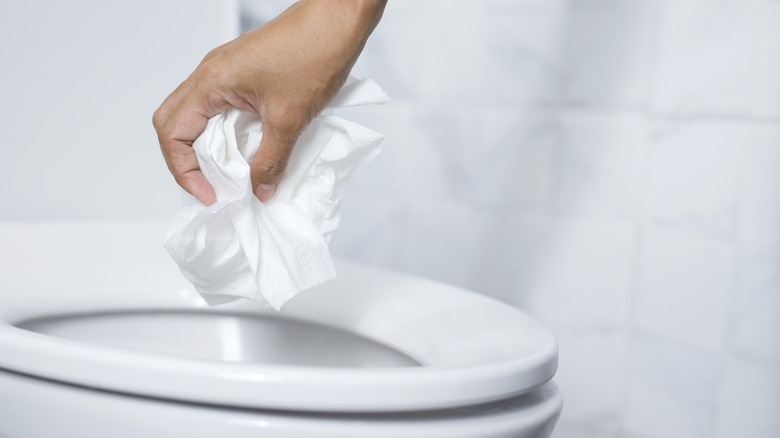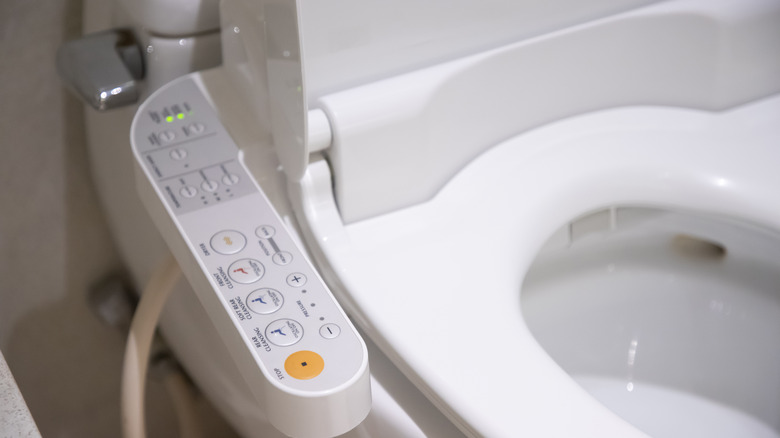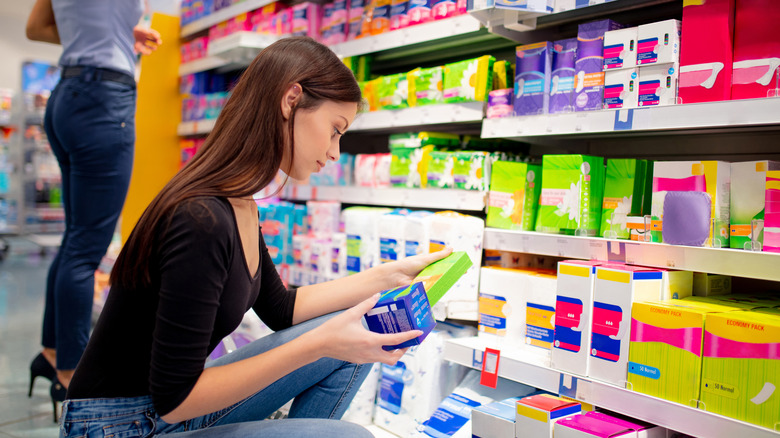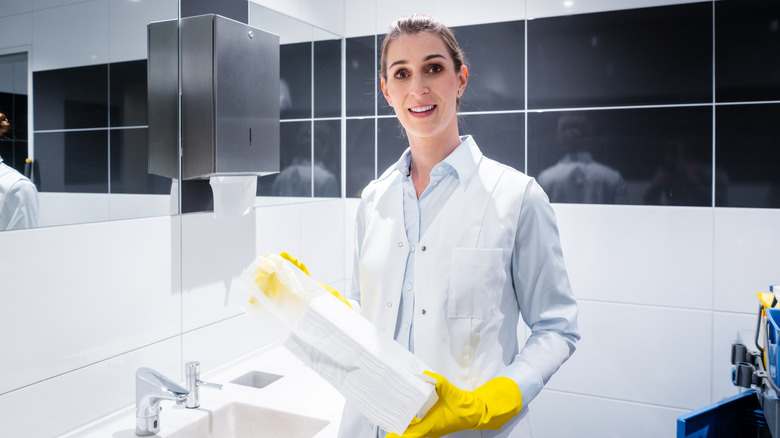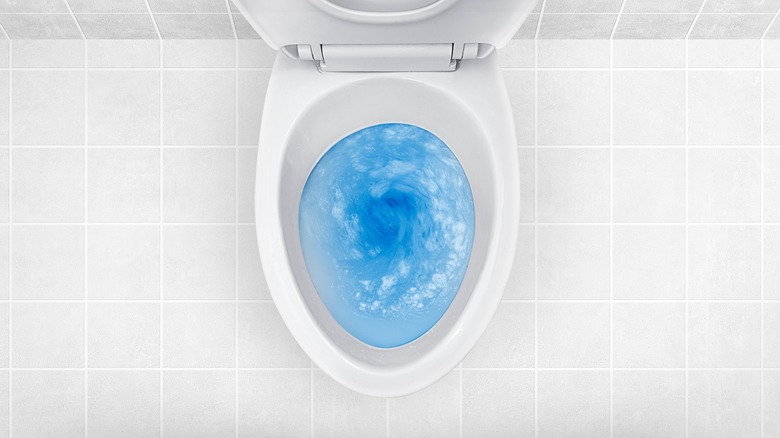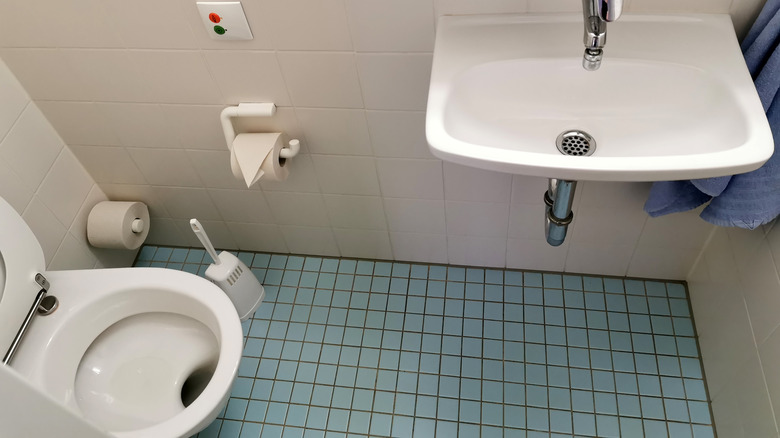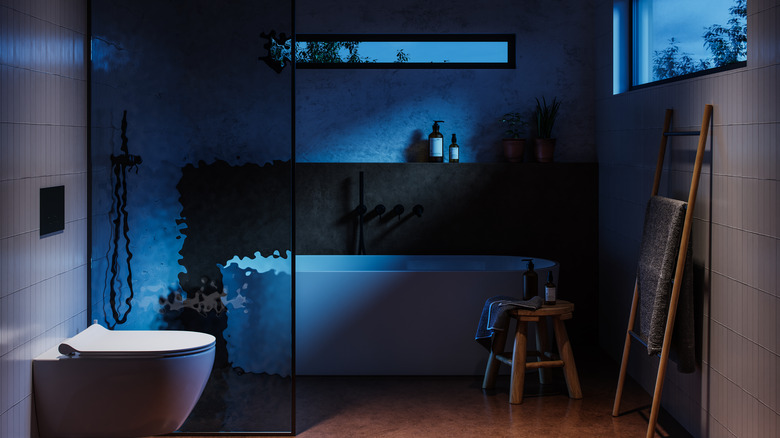Avoid These Embarrassing Bathroom Mistakes When Visiting Different Countries
If there's one thing that connects us all, it's that we all have to use the bathroom. However, not all restrooms and toilet customs are the same. While traveling, you'll likely encounter various types of toilets, different restroom rules, and some taboos surrounding toilets. When nature calls, it's important to know what to expect before you go to avoid making embarrassing bathroom mistakes.
One of the biggest mistakes travelers make is assuming toilets in different countries will be just like they are at home. It can come as a shock to find that everything from the toilet seat to the flushing systems can be vastly different. Then there are the rituals surrounding restrooms, as what's commonplace in one country can be highly offensive in another. When in urgent need of a bathroom, no one wants to worry about what they should and should not do while "taking care of business." If you're planning a trip abroad, these are some common bathroom mistakes you should avoid when visiting different countries.
Don't forget to bring your own toilet paper
While toilet paper is an absolute must in many Western countries, it's important to be aware that it's not commonplace everywhere. Some countries have different cleaning systems like bidets, handheld showers (informally called bum guns), or water scoops. This includes several countries in Southeast Asia, the Middle East, and Africa. If you're not ready to give up toilet paper, you may want to carry some tissues when you visit countries where it is not typically used.
Even if toilet paper is common in the country you're visiting, it might not be readily available. For example, travel guru Rick Steves' revealed some unexpected toilet info you need to know before traveling to Europe. In the Travel Tips section of his website, he explained that there are some places in Europe where public toilets are free, but you have to buy toilet paper from an attendant. Then, of course, there is always the chance that the restroom is simply out of toilet paper. In the case of an emergency, it's best to be prepared.
Don't touch people with your left hand in some countries, because that hand is for toilet business
Speaking of toilet paper, many people around the world wouldn't dream of using it to clean up after using the toilet. For some, only water can adequately clean the body. This is often due to religious and cultural reasons. Some Muslim and Hindu texts state that water must be used for cleaning your nether regions and that only the left hand should be used to splash water down there. Standard practice is to use the right hand to hold the lota (water vessel) or water scoop and the left hand to use the water to clean.
In many countries where water is used in lieu of toilet paper, it's taboo to touch anyone with the left hand because that's the "toilet hand," so it's considered unclean. You should also avoid using your left hand to touch food, pass money or gifts, and point at people. Many countries with Muslim and Hindu populations follow this rule, including Indonesia, India, Nepal, Malaysia, and Bangladesh. It's also commonplace across the Middle East.
Don't forget to bring some cash because you may have to pay to use public toilets
North Americans often take free toilets for granted. In many other parts of the world, you must pay to use public restrooms. When it comes to Europe, Rick Steves says, "Paying to use a public WC is a European custom that irks some Americans. But isn't it really worth a few coins, considering the cost of water, maintenance, and cleanliness? And you're probably in no state to argue, anyway. Pay toilets are the norm at highway rest areas, train stations, and even at some sights — hang on to your small change for WC stops."
Many European countries have coin-operated restrooms where you pay a few coins to unlock the door. Newer versions might also allow you to tap your debit or credit card to pay. In other places like Mexico, Chile, and most of Southeast Asia, it's more common to have attendants at public restrooms who will take your money and may or may not give you toilet paper. If you visit a free restroom with an attendant, it's polite to leave a few coins.
Don't mix up the house slippers and bathroom slippers in Japan
Japan is a fascinating country with a wide array of customs that are vastly different from many other places. For example, most Japanese people never wear shoes in the home. Instead, they swap outdoor shoes for slippers when in the house, and there are often different slippers for the bathroom as well. One of the biggest things tourists should never do when visiting Japan is mix up the bathroom slippers with the regular house slippers.
The "no-shoe" rule in Japan comes down to cleanliness. The logic is that outdoor shoes track dirt and germs into the house. Toilets can also be wet and dirty places. Therefore, most Japanese homes and some businesses have slippers at the entrance of the home or business that are meant to be worn around the house, as well as slippers at the entrance of the bathroom that are intended for use only in the bathroom. If you use the restroom, be sure to swap out your house slippers for the bathroom slippers before you go, and remember to swap them back once you're done.
Don't get stuck not knowing how to ask where the bathroom is
When you have to go, you have to go, and the last thing you want is to waste time trying to blunder through a language barrier to find the nearest toilet. A quick fix might be to pop into the first café or restaurant you see. But even then, you'll still need to let someone know that it's a restroom you're looking for. If there's only one phrase you can learn in another language, it should be, "Where is the bathroom?"
One handy tool to help you find the nearest bathroom while traveling is the Flush Toilet Finder app. The app pinpoints your location and shows you all the public restrooms within your vicinity. It also tells you whether the restroom is a pay toilet or free and whether it is wheelchair accessible. In addition, it gives you directions to the loo of your choice. Great for road trips and forays to new cities, the app can save precious time when you need it most.
Don't sit on the seat in some Asian countries
If you're planning a trip to Asia, be aware that squat toilets are the norm in many countries. Squat toilets are typically built low to the ground because they're meant to be squatted over rather than sat on. Some may have toilet pan with areas on either side to place your feet, while others could be a low bowl or even just a hole in the ground. Some squat toilets have a flushing mechanism, while others need to be flushed manually by taking a container of water and pouring it into the toilet.
Jen Williams of Launch Your Travels gave a few tips for using squat toilets. First, she recommends rolling up your pants or skirts so that they don't get wet (or worse). She also suggests making sure you don't have anything in your pockets that could fall out. Although it seems obvious, wearing shoes is also important. She said, "You may be wondering right now, why wouldn't I be wearing any shoes? Well, you would be surprised at how many places make you take your shoes off in certain destinations. Temples and restaurants are the two big ones that could require you to take your shoes off."
Don't get flustered trying to figure out how to flush the toilet
Wouldn't it be great if all toilets were the automatic flushing variety? Sadly, that's not the case in many destinations. Flushing systems vary across the world, so it pays to do some research before you travel to get an idea of what you might come across. After all, you don't want to leave an unpleasant surprise for the next person who needs to go. Likewise, you probably don't want to spend any more time than you have to in a public washroom searching for the flushing mechanism.
One thing you might come across in Europe is toilets with a pull string instead of a handle or button for flushing. These toilets typically have a tank on the wall with a chain you can pull to flush the toilet. In other places, the toilet may have a foot pedal for flushing. Then, there are the aforementioned squat toilets, many of which need to be flushed manually with a bucket or scoop of water.
Don't flush toilet paper in certain countries
Clogging up a toilet and causing a flood is bad enough at home, but it can be a shameful nightmare while traveling. In some places, all it might take is flushing your toilet paper. Many countries don't have plumbing systems that can support toilet paper, so the last thing you want to do is throw paper or anything more robust into the bowl. As a general rule, if it didn't come out of your body, it shouldn't go down the pipes.
Countries where toilet paper shouldn't be flushed include Greece, Egypt, China, Brazil, and India. Parts of Southeast Asia, South America, and the Caribbean can also have ill-equipped plumbing and sewage systems that can't handle toilet paper. In places where flushing toilet paper is discouraged, it's best to dispose of your paper in the bins provided or do like the locals do and use water for cleaning.
Don't push the buttons on a Japanese toilet unless you know what you're doing
Japanese toilets can be truly awe-inspiring. Many high-tech models have a slew of handy features like spray washers, dryers, seat warmers, and even "courtesy music." You can activate these features using the buttons on a control panel that can usually be found on the side of the toilet or the wall of the restroom. If you're lucky, there may be pictures or some English to help you decipher what button does what. More often than not, they will only have Japanese characters.
Japanese toilets can be bewildering to foreigners who aren't familiar with them. Press the wrong button, and you could be sprayed with a stream of water or send out an emergency call for help. Even locating the flush button can be problematic. If you're planning a trip to Japan, you may want to brush up on your toilet button symbols, and Coto Academy has a great primer. Another essential travel hack when visiting Japan is to download a good translation app, and Google Translate has a genius feature that allows you to translate text with your camera.
Don't expect the same hygiene products abroad
When it comes to personal hygiene products, you might be particular about the brands and types of products you use. That's all fine and well, but don't assume you'll find the same items overseas. If there are certain toiletries that you can't do without, consider bringing them with you on your trip. At the very least, you may want to bring hand sanitizer or wipes for those bare-bones bathrooms that offer nothing more than water for cleaning up.
If you happen to be traveling during that time of the month, it's also important to be aware that tampons are not common in many countries. You may have to search hard to find them or resort to pads. In addition, you may not find the same brands or types of products that you're used to at home. For example, you may not find tampons with applicators or thin pantyliners. In some rural areas, you may not be able to find any menstrual products at all. It's best to bring some with you, just in case.
Don't forget to tip the bathroom attendant in some European countries
Some bathrooms in Europe have attendants who clean the facilities and may hand out or sell hygiene products. You may find bathroom attendants in train station restrooms, restaurants, or public WCs. Often, they have a tray set up where you can leave them a tip for their services. If it's a free toilet, there is no set amount you need to leave, but many people suggest leaving anywhere from 25 to 70 cents.
If you're visiting Europe from a country where public toilets are ubiquitous and free to use, it may seem preposterous to tip for the pleasure of going pee. But keep in mind that these people spend a significant amount of time in a space that most people want to get in and out of as quickly as possible. In addition, many bathroom attendants ensure the spaces are clean and contain everything you need for a comfortable bathroom break. A few coins is a small price to pay to show your appreciation.
Don't forget to flush in Singapore
It's always rude to leave a toilet unflushed, but in Singapore, you could incur a hefty fine for leaving your business in the bowl. The Environmental Public Health Act (regulation 16) states, "Any person who has urinated or defecated in any sanitary convenience with a flushing system to which the public has access shall flush the sanitary convenience immediately after using it." Not flushing can land you a fine of up to $1,000 SGD (about $745).
Singapore is known for having some pretty strict rules related to public cleanliness. For example, it's the only Asian country where chewing gum is banned. Luckily, the fixation on cleanliness means there are plenty of self-flushing toilets in the city-state. And if you do forget to flush, it may not be as dire as you think because the no-flushing rule is a pretty hard one to enforce. As one Singapore resident said on Quora, "So far as I know, NO ONE has ever been fined for not flushing their toilets because there has NEVER BEEN 'Toilet Police/Security' or CCTV put inside the toilet to catch you not flushing."
Don't be shocked by the toilet shelf in some European toilets
You may be surprised that some toilets in Europe have a flat shelf to catch waste instead of a water-filled bowl. These types of toilets are found mainly in Germany, the Netherlands, Austria, and Hungary. It can be disconcerting to look down and see everything just sitting there on what many call a "poop shelf." But not to worry — once you flush, water flows from the back of the shelf to push the waste into the drain below. While some may find these types of toilets strange, others say they serve some important purposes.
According to Tiffany Jarman Jansen on Expatica, "The flachspeuler (German for 'flat-flusher', i.e., the shelf design) may not be the most pleasant of toilet models, but it does have its advantages. Besides the opportunity to do a health check, the design and flushing system of these toilets saves water. Plus, they save you from being splashed with toilet water with each deposit." Downsides include the visuals, odor, and the fact that sometimes, not everything gets fully flushed away.
Don't make bathroom noises before 7 a.m. or after 10 p.m. in Switzerland
One toilet mistake to avoid making in Switzerland is getting up in the middle of the night to use the bathroom, as most municipalities have mandatory quiet hours between 10 p.m. and 7 a.m. If your toilet activity or plumbing is excessively noisy, your neighbors may take offense. Being a good neighbor is important in Switzerland, so much so that the civil code says that your activities cannot have an excessive impact on your neighbors.
That said, you're unlikely to face any criminal charges if you flush your toilet at night. Although the law doesn't specify exactly which noises are "excessive," most people accept normal household noises. The law is more geared towards disruptive noises like loud music, power tools, and mowing the lawn. As long as you're being considerate, you probably won't have any problems. Just don't slam that bathroom door, and you should be good to go.
